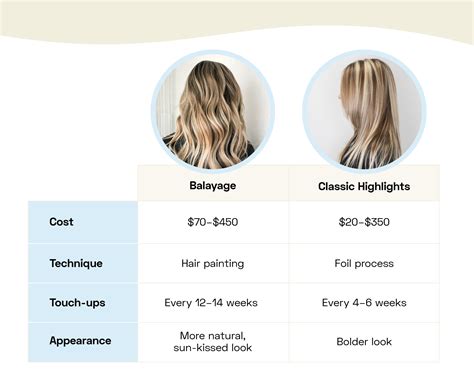Introduction
In the realm of hair coloring, two techniques reign supreme: highlighting and balayage. Both methods can dramatically transform your locks, but they differ in their application, effect, and maintenance. Let’s delve into the world of highlights vs balayage and uncover their unique charms.

Highlights
Definition:
Highlighting involves strategically bleaching small sections of hair to create a contrasting effect. The result is a noticeable difference between the lightened and natural hair colors, giving the illusion of dimension and volume.
Key Features:
- Precise placement to enhance specific areas of the hair
- Creates a bolder, more defined look
- Perfect for adding contrast and brightening dark hair
Balayage
Definition:
Balayage is a freehand painting technique that mimics the natural sun-kissed effect. Color is applied to the mid-lengths and ends of the hair, seamlessly blending with the roots and creating a gradual transition.
Key Features:
- Natural, sun-kissed appearance
- Subtler gradation of colors
- Ideal for achieving a beachy, effortless look
Application Techniques
Highlighting:
- Foil or plastic wrap is used to separate sections of hair.
- Bleach is applied directly to the targeted areas.
- The hair is then wrapped and processed for the desired amount of time.
Balayage:
- Color is applied freehand using a brush or comb.
- The stylist chooses the placement and direction of the color.
- Foil is not used, allowing for a more natural and diffused effect.
Maintenance and Longevity
Highlighting:
- Requires regular touch-ups to maintain the contrast.
- Can damage the hair due to repeated bleaching.
- May fade more quickly than balayage.
Balayage:
- Less frequent touch-ups are required due to the gradual transition of colors.
- More forgiving on the hair as less bleach is used.
- Tends to last longer and blend better with hair growth.
Comparison Table
| Feature | Highlight | Balayage |
|---|---|---|
| Effect | Bold, contrasting | Natural, sun-kissed |
| Application | Precise, foil-wrapped | Freehand, painted |
| Maintenance | Regular touch-ups | Less frequent touch-ups |
| Hair Damage | More potential damage | Less potential damage |
| Longevity | May fade more quickly | Tends to last longer |
Cost Considerations
The cost of highlighting or balayage depends on several factors, including the length and thickness of the hair, the desired effect, and the location of the salon. According to the American Association of Cosmetology, the average cost for a full head of highlights ranges from $150 to $500. Balayage typically costs between $100 and $300.
Which Technique is Right for You?
The choice between highlighting and balayage ultimately depends on your personal preferences and hair goals. Consider the following factors:
- Desired look: Do you want a bold, contrasting effect or a more natural, blended look?
- Hair type: Highlights can emphasize finer hair textures, while balayage works better on thicker hair.
- Maintenance time: Balayage requires less frequent touch-ups than highlighting.
- Budget: Balayage tends to be more affordable than highlighting.
Tips and Tricks
- If you have dark hair, consider using a demi-permanent dye for highlights to avoid excessive damage.
- For a more natural balayage, choose colors that are close to your natural hair color.
- Add a gloss treatment to your hair after highlighting or balayage to enhance shine and reduce hair damage.
- Protect your color-treated hair from the sun by using UV-protective hairspray or a hat.
Step-by-Step Approach to Balayage
- Section the hair into small, manageable pieces.
- Choose the placement and direction of the color.
- Apply the color freehand using a brush or comb.
- Allow the color to process for the recommended amount of time.
- Rinse the color thoroughly.
- Tone and style the hair as desired.
Pros and Cons
Highlighting:
Pros:
- Bold and dramatic effect
- Creates dimension and volume
- Ideal for enhancing hair texture
Cons:
- Requires regular touch-ups
- More potential hair damage
- May fade more quickly
Balayage:
Pros:
- Natural, sun-kissed appearance
- Less frequent touch-ups
- Less potential hair damage
- Tends to last longer
Cons:
- More difficult to achieve precise placement
- May not be suitable for all hair types
- Takes longer to apply
Conclusion
Highlighting and balayage offer distinct approaches to hair coloring, each with its unique advantages and drawbacks. Whether you desire a striking contrast or a subtle, sun-kissed glow, choosing the right technique can help you achieve your hair goals. Remember to consult a professional stylist to determine the best option for your individual needs.
